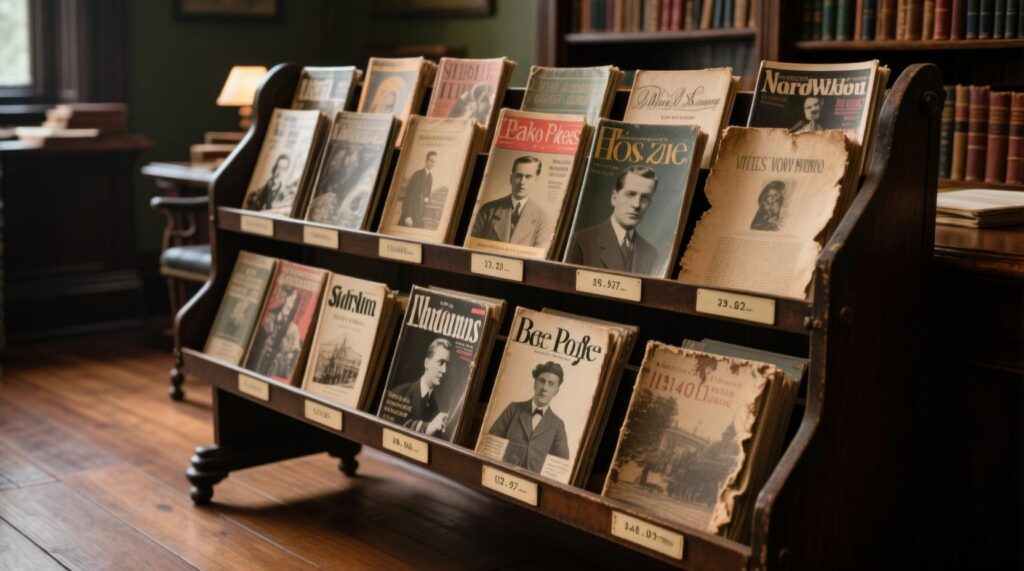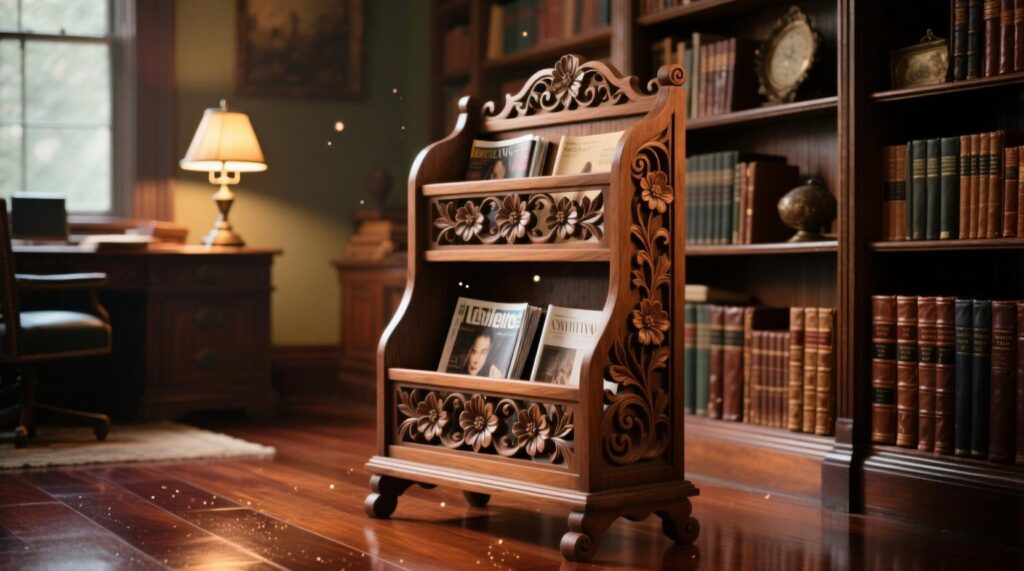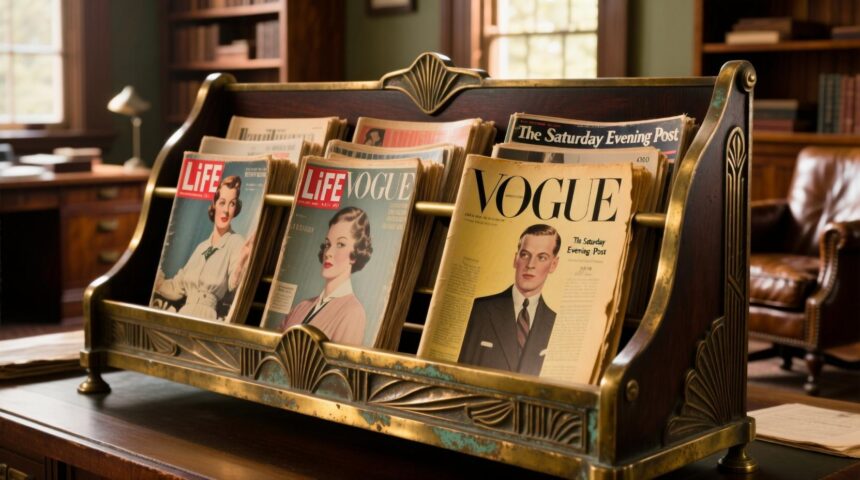An antique magazine rack is more than just a simple holder for newspapers or periodicals—it’s a piece of history, craftsmanship, and style. These racks, often made from fine wood, brass, wrought iron, or wicker, were designed during a time when reading printed material was a daily ritual. Unlike today’s mass-produced storage solutions, antique magazine racks showcase detailed artistry, unique designs, and high-quality materials that have stood the test of time.
Collectors and interior decorators appreciate these pieces for both their functionality and aesthetic appeal. While vintage racks are from the mid-20th century, true antique magazine racks are generally over 100 years old, reflecting styles from the Victorian, Edwardian, and early 20th-century periods.
2. History & Evolution of Magazine Racks
The idea of organizing periodicals began in the 19th century, a time when newspapers and magazines became an essential part of middle-class households. Early designs were simple wooden frames, but as printing technology grew and publications flourished, furniture makers began creating racks with ornate details.
Timeline of Evolution:
| Era | Notable Design Traits | Common Materials |
|---|---|---|
| Victorian Era (1837–1901) | Heavy carvings, dark wood, floral motifs | Mahogany, oak, walnut |
| Edwardian Era (1901–1910) | Lighter designs, more curves, elegance | Mahogany, beech, brass |
| Art Deco (1920s–1940s) | Geometric shapes, modern look | Chrome, lacquered wood |
| Mid-century Modern (1950s–1960s) | Minimalist, clean lines | Teak, steel, rattan |
By the mid-20th century, many magazine racks became multifunctional—sometimes including side tables or built-in lamp stands.
3. Common Materials Used in Antique Magazine Racks
A key factor in identifying and valuing an antique magazine rack is the material used in its construction:
- Wood – Mahogany, oak, and walnut were prized for their durability and rich grain.
- Metal – Brass and wrought iron were popular for intricate designs.
- Wicker & Rattan – Lightweight yet sturdy, these became popular for cottage-style décor.
- Combination Designs – Some antique magazine racks combined wooden frames with metal holders for added strength.
The material also determines how the piece ages. For instance, brass develops a beautiful patina, while wood darkens and gains character over decades.
4. Design Styles & Period Influences
Antique magazine racks often reflect the artistic movements of their time:
- Victorian Style – Elaborately carved wooden frames, often with floral patterns.
- Edwardian Style – Elegant curves, lighter woods, and more refined proportions.
- Art Deco – Geometric shapes, symmetrical lines, and bold contrasts.
- Mid-Century Modern – Sleek, functional, and minimalist.
- Rustic/Farmhouse – Simple designs, often in pine or oak, with a natural finish.

5. Identifying an Authentic Antique Magazine Rack
Not all old magazine racks are truly antique. Here’s how to identify a genuine piece:
- Signs of Age: Look for wear on handles, edges, and joints.
- Craftsmanship Clues: Antique racks often have dovetail joints, hand-carved details, and sturdy construction.
- Maker’s Marks: Check for brand stamps, engravings, or labels on the underside.
- Patina: The natural darkening of wood or tarnishing of metal indicates genuine age.
- Tool Marks: Visible chisel or plane marks can suggest handcrafting.
Tip: Use a magnifying glass to inspect joinery—machine-cut joints often indicate newer reproductions.
6. Popular Antique Magazine Rack Shapes & Structures
Some of the most collectible designs include:
- Freestanding Floor Racks – Larger and often ornate, ideal for living rooms.
- Wall-Mounted Racks – Space-saving and decorative.
- Rotating Racks – Common in public spaces like libraries.
- Folding Racks – Portable and easy to store.
Each style serves different purposes, from showcasing books to storing sheet music.
7. Notable Manufacturers & Designers
While many antique magazine racks were made by local craftsmen, some renowned makers include:
- Liberty & Co. (UK) – Known for Arts and Crafts-style racks.
- Stickley Brothers (USA) – Famous for Mission-style wooden furniture.
- Thonet (Austria) – Innovators of bentwood magazine stands.
8. Collecting Antique Magazine Racks
Collecting an antique magazine rack is both a hobby and an investment. You can find them in:
- Antique shops
- Estate sales
- Online marketplaces (e.g., eBay, Etsy)
- Specialty auctions
Value Factors:
- Age and rarity
- Condition and originality
- Craftsmanship quality
- Maker’s reputation
A rare 19th-century carved mahogany rack can be worth several hundred dollars, while simpler mid-century pieces might sell for $50–$150.
9. Restoration & Care Tips
To maintain an antique magazine rack’s value:
- Cleaning: Use a soft cloth and gentle wood polish—avoid harsh chemicals.
- Repairing: Tighten loose joints carefully; for major damage, hire a restorer.
- Preservation: Keep away from direct sunlight and humidity.
Common Mistake to Avoid: Over-sanding or re-staining wood can strip away its historical patina, reducing its value.
10. Incorporating Antique Magazine Racks into Home Décor
An antique magazine rack can blend seamlessly into various décor styles:
- Traditional Homes: Use as intended, to store reading materials.
- Modern Interiors: Repurpose as a wine holder or mail sorter.
- Rustic Spaces: Fill with blankets or plants for a cozy touch.
11. Market Trends & Investment Potential
The market for antique magazine racks has remained steady, with particular growth in interest for mid-century modern and rustic designs. Unique racks with elaborate craftsmanship or from famous makers often appreciate in value.
Example: A 1920s Art Deco chrome magazine rack once sold at auction for over $800 due to its rarity and pristine condition.

12. Conclusion
An antique magazine rack is more than just a storage accessory—it’s a conversation piece, a historical artifact, and a functional work of art. Whether you’re a seasoned collector or someone decorating your home with unique finds, these racks offer timeless beauty and practical use. By understanding their history, materials, and craftsmanship, you can make informed choices and enjoy these treasures for years to come.
